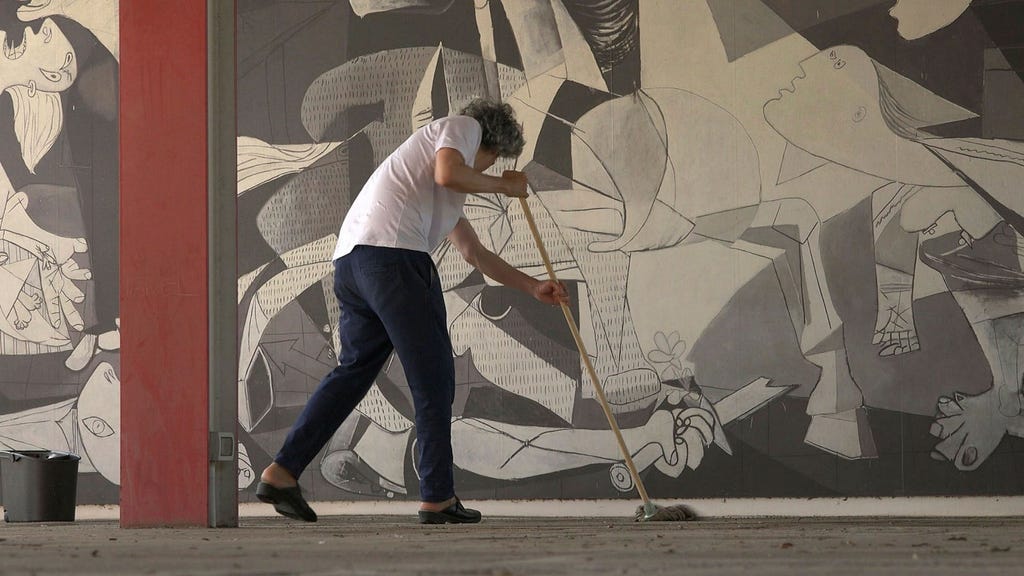Runo Lagomarsino’s exhibition at Konsthallen Marabouparken, revolving around Picasso’s iconic ”Guernica,” is not merely a display of artworks but a carefully constructed exploration of historical echoes, spatial displacements, and the enduring power of art to transcend its immediate context. Lagomarsino doesn’t attempt to replicate or directly interpret ”Guernica” but rather uses it as a lens through which to examine the complex interplay of time, memory, and political realities. His works create a dialogue with Picasso’s masterpiece, exploring its historical significance while simultaneously questioning its fixed position in the art historical canon. The exhibition becomes a platform for reflecting on the mutable nature of meaning and the ways in which historical events continue to resonate in the present.
Lagomarsino’s artistic strategy involves weaving together disparate threads, connecting seemingly unrelated historical moments and geographical locations to create a multi-layered narrative. He juxtaposes objects and images from different eras, prompting viewers to consider the invisible connections between them. This approach resonates with the fragmented nature of memory itself, where fragments of the past intermingle and coalesce in unexpected ways. The exhibition space itself becomes a stage for this temporal and spatial interplay, with the arrangement of the works encouraging viewers to move between different historical perspectives and geographical viewpoints. This deliberate blurring of boundaries challenges traditional notions of linear time and fixed spatial relationships, creating a dynamic environment that encourages active engagement with the artwork and its underlying themes.
The choice of ”Guernica” as a central point of reference is significant, given its status as a powerful symbol of anti-war sentiment and the horrors of conflict. Lagomarsino doesn’t simply rehash the familiar narrative of the Spanish Civil War and the bombing of Guernica; instead, he uses Picasso’s painting as a springboard to explore broader themes of violence, displacement, and the ongoing struggle for human rights. He examines the ways in which historical trauma can manifest in the present, emphasizing the continued relevance of ”Guernica” in a world still grappling with conflict and political instability. By drawing connections between the historical context of ”Guernica” and contemporary issues, Lagomarsino underscores the cyclical nature of history and the importance of remembering the past to avoid repeating its mistakes.
Lagomarsino’s work often involves the recontextualization of existing objects and images, imbuing them with new layers of meaning. He might take a seemingly mundane object, such as a piece of furniture or a historical document, and place it within a new narrative framework, thereby transforming its significance. This act of recontextualization encourages viewers to question their assumptions about the objects they encounter and to consider the multiple narratives that can be woven around them. This approach reflects a broader interest in the ways in which history is constructed and the role of interpretation in shaping our understanding of the past. By disrupting conventional narratives and offering alternative perspectives, Lagomarsino challenges the notion of a singular, objective historical truth.
The exhibition also explores the complex relationship between art and politics, questioning the role of the artist in times of conflict and social upheaval. Lagomarsino’s works are not overtly political statements; rather, they engage with political themes in a subtle and nuanced way, inviting viewers to contemplate the ethical and social dimensions of art. He avoids didactic pronouncements, preferring to create spaces for reflection and dialogue. The exhibition doesn’t offer easy answers but instead encourages viewers to grapple with complex questions about the relationship between art, history, and political responsibility. This approach acknowledges the power of art to provoke thought and generate critical engagement with the world around us.
Ultimately, Lagomarsino’s exhibition is an invitation to reconsider the relationship between past, present, and future. By using ”Guernica” as a touchstone, he explores the enduring legacy of historical events and the ways in which they continue to shape our present. The exhibition is not simply a commentary on Picasso’s masterpiece; it is a broader reflection on the nature of memory, the complexities of history, and the ongoing struggle to create a more just and equitable world. Lagomarsino’s artistic interventions encourage viewers to engage actively with these complex themes, prompting them to question their own assumptions and to consider the multiple perspectives that shape our understanding of the past and its relevance to the present. The exhibition becomes a space for dialogue and reflection, a place where viewers can grapple with the enduring questions raised by ”Guernica” and its continuing resonance in a world still grappling with conflict and social injustice.














